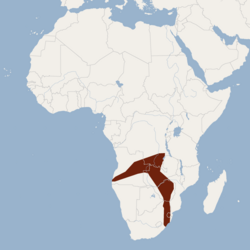| Anchieta's serotine | |
|---|---|
| Scientific classification | |
| Kingdom: | Animalia |
| Phylum: | Chordata |
| Class: | Mammalia |
| Order: | Chiroptera |
| Family: | Vespertilionidae |
| Genus: | Neoromicia |
| Species: | N. anchietae |
| Binomial name | |
| Neoromicia anchietae (Seabra, 1900) | |
 | |
| Synonyms [2] [3] | |
| |
Anchieta's serotine (Neoromicia anchietae), [3] formerly known as Anchieta's pipistrelle, is a species of vesper bat. It is found in Angola, Democratic Republic of the Congo, South Africa, Zambia, Zimbabwe and Madagascar. The species inhabits savanna habitats.
